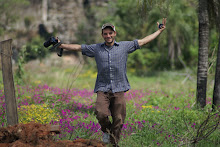
Paraguay is not known for anything. Land locked in the heart of South America; it is a country of six million, the size of California, swallowed up geographically by its neighbors, Bolivia, Brazil and Argentina. Outdoor enthusiasts would not be looked at cross wise for moving from the beaches of Rio de Janeiro to the high peaks of the Andes and on down to the wind sweep plains of Patagonia without giving Paraguay a second thought. Globe trotting climbers would give even less of their fanatically driven attention for big walls and vertical spires to lowly Paraguay.
No longer.
Over the past year, three individuals have been quietly cultivating their climbing passion in a country as far off the map and as virgin as any modern day explorer could dream.
In the established world of climbing where first ascents and new routes are discussed and determined by degree, Climbing in Paraguay by contrast is wide open. Climbing in the town of Tobati, seventy kilometers northeast of Paraguay’s capital Asuncion, former Peace Corps Volunteers Jonathan Bibee and Dale Helm, along with close Argentine friend Hugo Vidomlansky recently bolted the first handful of sport routes in the country. With kilometers of unexplored wall and the sun shining hot and bright, there is much to be done.
Although Paraguay is not fated to become a premier climbing destination, nevertheless there is a certain sense of pride and a sparkle of contentment knowing that first ascents are not reserved only for the most elite of climbers on location in some exotic locale.
Beyond the convoluted jargon and often times contrived international climbing culture Paraguay Climbing offers a newness, a freshness, a rawness that harkens back to the days of yore when people went barefoot up the rock face and possibilities were endless.
Taking full advantage of the collective experience and improvements gained over the past fifty years in terms of climbing gear (bought in Argentina or Brazil or hand carried down from the USA), climbing techniques and code of ethics, Bibee, Helm and Hugo Vidomlansky, have discovered a climbing area where it can be applied completely from the ground up.
Constructively and consciously developing unknown walls and a brand new sport that infuses courage, self confidence, communication, fun and awareness to the Paraguayan populace, Bibee and Helm relish the challenge of doing what they love, loving what they do and making it accessible to any and all Paraguayans willing to step into a harness and confidently call out the climbing commands “On Belay…. Climbing.”

